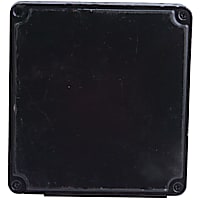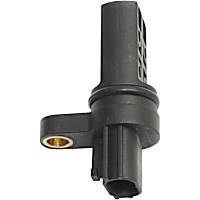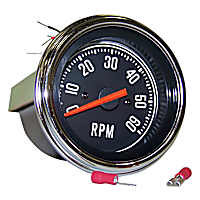Having trouble figuring out what a P0339 code means and how to fix it? Read through this article to learn more about code P0339.
What Does the P0339 Code Mean?
Diagnostic trouble code (DTC) P0339 stands for “Crankshaft Position Sensor “A” Circuit Intermittent. It indicates that the powertrain control module (PCM) has detected an irregular signal or failed to detect one from the crankshaft position sensor.
The ECM/PCM always needs to know the speed and position of the crankshaft – this is a foundational input without which the engine won’t start on most vehicles; one exception would be some late model Dodge vehicles.
The following section will discuss a few examples of how P0339 is set on different vehicle platforms. You may also quickly jump to the possible causes of P0339.

P0339 on Different Vehicles
This code isn’t a very common code, and only a few vehicle platforms include a P0339. The P0335 is more common and has a very similar meaning and definition. But the P0339, while it means the same thing, is monitored differently on the vehicles that have this code listed.
On a 2018 Dodge Challenger:
- The PCM identifies the crankshaft position angle by recognizing the “missing” tooth on the crankshaft sensor reluctor. The missing tooth is the largest feature of the crankshaft tone wheel. This identification process (when the missing tooth is detected) is said to “lock” the crank signal.
- The crankshaft sensor may be an inductive (analog wave) sensor or it may be a Hall-Effect (digital square wave) sensor. Either way, the missing tooth is the most important pulse.
- The PCM determines the camshaft position angle by recognizing the unique features on the Camshaft tone wheel so that it can identify camshaft angle. Once the Camshaft signal pattern sequence is stored on a particular starting event, it is also said to be “locked.”
- When both “locked” conditions are satisfied, the engine is considered “synchronized” and the ignition timing and fuel injection for the engine will begin.
- Engine speed and misfire detection are also determined using the CKP signal.
- When the PCM notices an interruption in the “locked” pattern recognition of the CKP signal, it is said to be “unlocked.”
- The PCM will try to re-establish pattern recognition. If the PCM fails to reestablish pattern recognition, or if the CKP Signal “unlocks” more than a predetermined number of times within a calibrated time threshold, the P0339 is set.

On a 2018 Toyota Corolla:
Prerequisite conditions before P0339 can be set:
- Engine speed is 1000 rpm or higher.
- Starter signal off.
- 3 seconds or more have elapsed since starter signal switched from on to off.
Under all three of the above conditions, no crankshaft position sensor signal is detected at the ECM for at least 0.05 seconds (1 trip detection logic).
Note: As stated before, this code basically has the same definition but is set using different criteria on different platforms. With that in mind, realize that the definition of code P0339 may be slightly different from one vehicle/platform to the next depending on the vehicle manufacturer. Consult the appropriate repair manual or repair database for the exact code definition.

What are the Possible Causes of the P0339 Code?
Here are some common triggers of the error code P0339:
- Defective crankshaft position (CKP) sensor or reluctor wheel
- Issues with the CKP circuit, such as damaged wires and poor connections
- Faulty PCM or PCM programming error
- Issues with the timing belt or timing chain
What are the Common Symptoms of the P0339 Code?
Depending on the severity, other related diagnostic trouble codes may also be stored. The check engine light will also be activated. Generally, you may notice the following symptoms if you drive a vehicle with a P0339 trouble code:
- Decreased engine performance
- Engine may not start
- Increased fuel consumption
- Hesitation upon acceleration
- Tachometer does not register RPM when the engine is cranked
How to Diagnose the P0339 Code
Error code P0339 is a generic code, which means it may appear across several makes and models. However, that does not mean that there’s a universal way to diagnose it. The diagnosis and repair of this code typically depend on your vehicle’s make and model.
Check out the videos below for a better understanding of how to troubleshoot this error code:
How to Fix the P0339 Code
Like most OBD-II codes, P0339 shares similar triggers and symptoms with many other engine codes. However, there is no universal way to resolve it. If you aren’t confident in your automotive repair skills, leaving it to the experts is the best course of action you can take.
The P0339 code could be triggered by anything from a defective CKP sensor to a PCM programming error, so you must do your research thoroughly. Usually, to fix this issue, a crankshaft position sensor replacement is in order.
Keep in mind that all vehicles are different. You should always consult your owner’s manual and the factory repair information before DIY-ing any repairs.
If you’ve decided on resolving this code yourself, you should read online auto repair sources for guidance. For instance, an ALLDATA subscription provides detailed factory repair information that you can use to accurately resolve issues in your car. It will also help you carry out other fixes in the future.
Where to Get a New Crankshaft Position Sensor for Your Vehicle
Don’t let your vehicle gather dust in the garage because of code P0339. If a faulty crankshaft position sensor triggered the code, don’t put off replacing it. With CarParts.com, you can get back on the road as soon as possible with our on-hand and ready-to-ship crankshaft position sensors.
Our crankshaft position sensors are made using the finest materials available and undergo strict quality checks to ensure maximum durability and dependability. Never second-guess part quality when you shop from us.
Find a direct-fit crankshaft position sensor replacement for your ride by entering its year, make, and model into our vehicle selector. For a more personalized shopping experience, use the search filters to find a product according to your preferred brand, price range, quantity, and more.
It only takes a few clicks to find what you need and place your order. You can also call us anytime using our toll-free hotline, and our team of round-the-clock customer service professionals will be ready to assist you.
Here at CarParts.com, all our products come with a lifetime replacement and low-price guarantee, so you don’t have to worry about breaking the bank for your repairs. Find top-notch replacement parts with an affordable price tag right here.
Check out our crankshaft position sensors today!
Products Mentioned in this Guide
Any information provided on this Website is for informational purposes only and is not intended to replace consultation with a professional mechanic. The accuracy and timeliness of the information may change from the time of publication.



 Engine Control Module
Engine Control Module
 Crankshaft Position Sensor
Crankshaft Position Sensor
 Tachometer
Tachometer


















